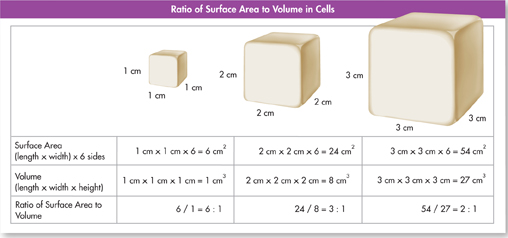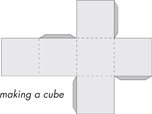
FIGURE 10–1 Ratio of Surface Area to Volume As the length of the sides increases, the volume increases more than the surface area. Interpret Tables What are the ratios comparing?
ddd
▸ Ratio of Surface Area to Volume Imagine a cell that is shaped like a cube, like those shown in Figure 10–1. The formula for area (l × w) is used to calculate the surface area. The formula for volume (l × w × h) is used to calculate the amount of space inside. By using a ratio of surface area to volume, you can see how the size of the cell's surface area grows compared to its volume.
Notice that for a cell with sides that measure 1 cm in length, the ratio of surface area to volume is 6/1 or 6 : 1. Increase the length of the cell's sides to 2 cm, and the ratio becomes 24/8 or 3 : 1. What if the length triples? The ratio of surface area to volume becomes 54/27 or 2 : 1. Notice that the surface area is not increasing as fast as the volume increases. For a growing cell, a decrease in the relative amount of cell membrane available creates serious problems.
Quick Lab
OPEN-ENDED INQUIRY
Modeling the Relationship Between Surface Area and Volume
-
Use the drawing and grid paper to make patterns for a 6-cm cube, a 5-cm cube, a 4-cm cube, and a 3-cm cube.
-
Cut out your patterns and fold them. Then use the tabs to tape or glue the sides together. Don't tape down the top side.
-
Construct a data table to compare the volume, the surface area, and the ratio of surface area to volume of each cube.
-
Use your data to calculate the number of 3-cm cubes that would fit in the same volume as the 6-cm cube. Also calculate the total surface area for the smaller cubes.

Review Describe the function of a cell membrane and its relationship to what happens inside a cell.
Apply Concepts How does the surface area change when a large cell divides into smaller cells that have the same total volume?
Analyze and Conclude
Table of Contents
- Formulas and Equations
- Applying Formulas and Equations
- Mean, Median, and Mode
- Estimation
- Using Measurements in Calculations
- Effects of Measurement Errors
- Accuracy
- Precision
- Comparing Accuracy and Precision
- Significant Figures
- Calculating With Significant Figures
- Scientific Notation
- Calculating With Scientific Notation
- Dimensional Analysis
- Applying Dimensional Analysis




